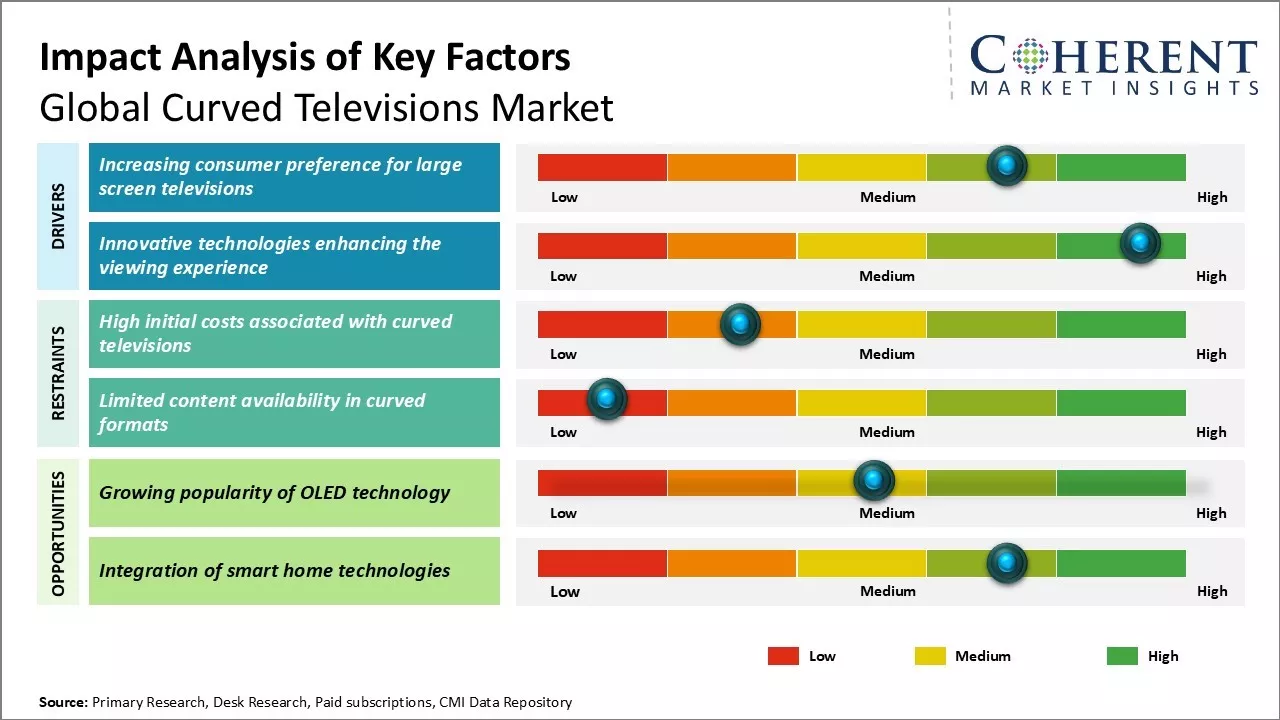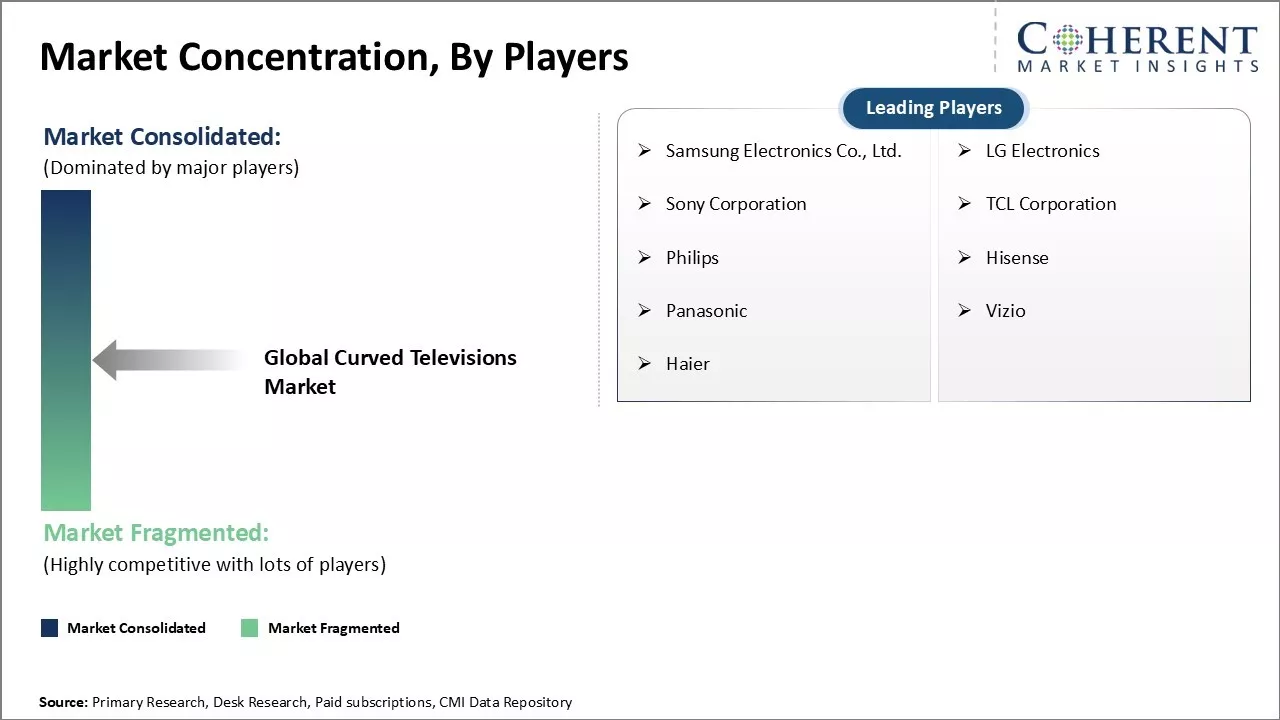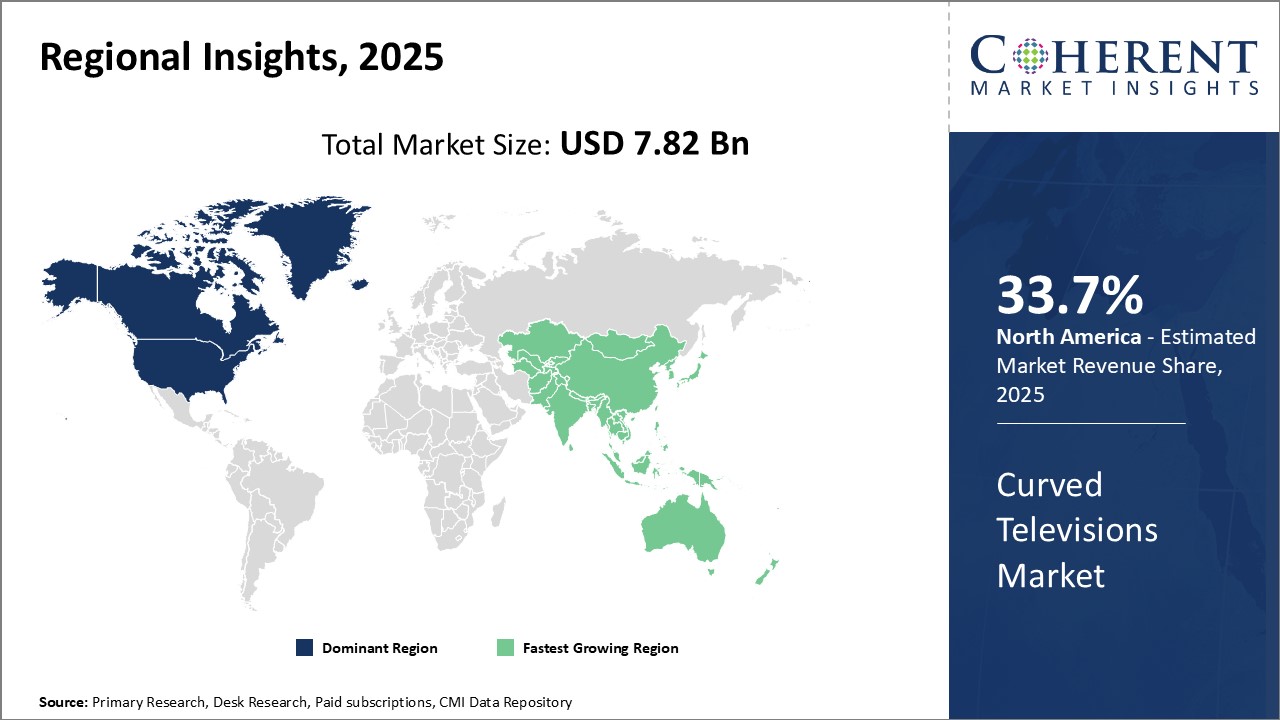The curved televisions market size is estimated to be valued at USD 7.82 Bn in 2025 and is expected to reach USD 54.03 Bn by 2032, exhibiting a compound annual growth rate (CAGR) of 31.8% from 2025 to 2032.

To learn more about this report, Download Free Sample
The curved televisions market is anticipated to experience consistent growth as consumers increasingly seek immersive viewing experiences and improved display technologies. The rising demand for home entertainment systems and high-definition content is expected to drive the adoption of curved televisions worldwide.
Also, improvements in screen resolution, design appeal, and the addition of smart TV features are some of the main drivers propelling the market growth. Curved displays provide a natural field of view and less distortion, which increases user experience and continues to gain popularity, particularly in high-end market segments.
However, the expensive price of curved televisions as opposed to flat-screen counterparts, limited content specifically designed for curved screens, and space limitations in smaller houses can limit broader usage. But higher availability through web retail channels and higher penetration in commercial environments like hotels and showrooms are anticipated to create new opportunities for growth in the curved televisions market up to 2032.
|
Current Events |
Description and its impact |
|
Revival of Premium Home Entertainment Demand |
|
|
Gaming Industry Influence on Display Preferences |
|
Uncover macros and micros vetted on 75+ parameters: Get instant access to report

To learn more about this report, Download Free Sample
The integration of smart features and artificial intelligence (AI) has emerged as a key trend shaping the curved televisions market. Modern curved TVs have transformed into entertainment platforms that perform multiple functions beyond showcasing superior visual performance. Through improved operating systems like Tizen, webOS, and Google TV, these gadgets offer effortless entry to streaming platforms, voice assistance like Alexa, Google Assistant, and Bixby, and a growing environment of smart applications. This integration of intelligence permits users to use voice or mobile commands to manipulate settings, seek out content, or control home automation devices, greatly enhancing convenience and interactivity.
AI has also improved picture optimization and personalization. Smart recommendation systems customize content for viewer interests, while AI capabilities like auto brightness, real-time scene detection, and adaptive sound adjustment enhance overall viewing experience. At CES 2025, Samsung unveiled some of the advanced AI capabilities in its new Neo QLED TVs, such as AI Upscaling, Auto HDR Remastering, and Adaptive Sound Pro. Other innovations such as "Click to Search," food identification through "Samsung Food," and gesture control with Galaxy Watch integration reflect the increasing use of AI in achieving a genuine connected and intuitive home theatre experience.
The curved television industry is anticipated to grow significantly, primarily due to several technological advancements such as OLED, QLED, and Mini-LED. These future-proof panels boast higher picture clarity, brightness, and color accuracy—making curved displays all the more desirable for viewers in search of home entertainment. The curvature creates a deeper sense of depth perception and diminished glare, with advanced display materials providing realistic, vibrant images.
By 2025, display innovation has reached even more heights with AI-enriched capabilities like adaptive sound optimization, AI picture tuning, and auto HDR remastering. In March 2025, Samsung Electronics America announced the availability of its 2025 Samsung Neo QLED 8K and Samsung Neo QLED 4K TV series. The new lineup offers stunning visuals and immersive sound, and are the first to feature Samsung Vision AI1 with smarter, adaptive features that reimagine Samsung TVs can do.
A major potential for the global curved televisions market is the increasing demand for OLED (Organic Light-Emitting Diode) technology. OLED provides better picture quality than conventional LCD and LED TVs due to its major strengths, including infinite contrast, pixel-level local dimming, greater color accuracy, and broader viewing angles. All these aspects improve the visual performance overall, offering more vivid, real-like pictures. As a result, curved OLED TVs have gained traction among consumers who value premium home entertainment experiences.
The demand for OLED technology is expected to grow as it continues to deliver unparalleled viewing quality, and as consumers increasingly seek cutting-edge features like superior contrast and color depth. The combination of curved design with OLED technology is particularly attractive for customers seeking immersive experiences, positioning it as a key growth area in the curved televisions market.
In the terms of type, the cable track cables segment is estimated to hold the highest share of the market of 72.7% in 2025. Cable track cables have seen increased demand from curved television manufacturers due to their flexibility and tensile strength. These cables are specially designed to withstand frequent twisting and bending without losing signal quality or breaking. Their cores are made of strong yet flexible materials like aircraft-grade aluminum alloy or stainless steel wrapped in protective PVC (Polyvinyl chloride) jackets.
In the terms of end user, the commercial segment is estimated to hold the highest share of the market of 61.9% in 2025. The commercial sector has seen the strongest growth in adoption of curved televisions. Various properties like malls, airports, restaurants, and corporate lobbies have been installing large curved screens for advertising, notifications, and entertainment. The immersive viewing experience provided by curved screens particularly suits such applications where audiences may only get fleeting glimpses of content as they walk by.

To learn more about this report, Download Free Sample
North America is set to lead the global curved televisions market in 2025, with estimates suggesting a market share of about 42.4%. This dominance is supported by a strong technological foundation, extensive high-speed internet penetration, and a consumer base willing to embrace new technologies.
A number of developments between 2022 and 2025 have reaffirmed this stance. In 2024, Walmart announced a US$ 2.3 billion purchase of smart television maker Vizio to boost its ad capabilities through connected TV platforms. This strategic acquisition enables Walmart to incorporate Vizio's smart TV data, furthering its ad-targeting expertise and growing its stake in the streaming advertisement industry.
In January 2025, TiVo launched its smart TV operating system, TiVo OS, into the U.S. market through a deal with Sharp. The platform provides a neutral interface with support for multiple streaming services and customized content recommendations, offering a competitor to entrenched players such as Roku and Amazon's Fire TV
Moreover, government initiatives promoting digital infrastructure and smart home integration have also played a role in this expansion. The combination of strategic corporate investments, technological advancements, and supportive policies positions North America as a continued leader in the smart TV industry.
The Asia Pacific region has become the fastest-growing market for curved TVs between 2023 and 2024 due to increasing disposable incomes, a growing middle class, and growing digitization in countries such as China, India, and Southeast Asia. The growth is also fueled by the fast adoption of smart TVs, with India recording smart TV shipments representing around more than 50% of overall TV shipments as of 2024.
Local manufacturers are growing their portfolios to address this increasing need. For example, In October 2023, TCL unveiled the C755 QD-Mini LED TV series in India, marking a significant step in catering to the growing demand for advanced television technologies. Available in sizes ranging from 55-inch to 98-inch, these TVs feature a 4K UHD resolution, 144Hz refresh rate, and support for various HDR formats, including Dolby Vision IQ. The integration of the AiPQ Processor 3.0 and Google TV OS enhances user experience with features like Game Master 2.0 and Dolby Atmos audio.
The growth of low-cost OTT subscriptions and the prevalence of high-speed internet further drove demand for smart TVs across the region. In Southeast Asia, approximately 34% of audiences streamed over-the-top (OTT) media in 2022, establishing a profitable market for smart TVs. Moreover, the expanding hospitality sector across the Asia Pacific is purchasing high-end television sets to drive guest experience, driving the overall market.
With these dimensions in place, the Asia Pacific curved televisions market is set for tremendous growth, mirroring the dynamic nature of consumer electronics in the region.
The U.S. curved televisions market is experiencing moderate but consistent growth, fueled by changing consumer tastes for immersive entertainment and display technology improvements. Major growth drivers are growing demand for high-definition home entertainment systems, the trend towards cinematic viewing at home, and growing interest in gaming—where curved screens provide improved peripheral visibility and depth. Consumers are expressing a preference for slim, high-performance TVs that improve both form and function in smart homes.
Technological innovation is playing the key role in directing the curved televisions market in the U.S. Manufacturers are incorporating technologies like AI-based picture and sound optimization, smart assistants, and smooth connectivity with IoT devices in the home. Further developments in QLED, OLED, and Mini-LED panels are enhancing picture quality, energy efficiency, and form factor flexibility. The developments are rendering curved TVs more appealing for consumers seeking premium visual experiences.
Curved televisions targeted at home consumers typically feature 4K UHD displays and come in screen sizes from 43 to 75 inches. Prices vary depending on display technology (LED, QLED, and OLED), smart features, and brand reputation.
Basic curved LED TVs from major brands like Samsung are generally priced between US$ 800 and US$ 1,300. These models include standard smart features and lower refresh rates.
Mid-tier models, often featuring QLED displays and larger screens (around 55 inches), fall in the range of US$ 1,300 to US$ 1,900. They offer improved image processing, better HDR support, and enhanced audio features.
Premium models with OLED or advanced QLED displays, AI upscaling, and immersive sound systems typically cost between US$ 2,000 and US$ 3,000.
Curved TVs used in commercial environments (e.g., hospitality, control rooms, or exhibitions) are designed for durability and superior display capabilities.
Professional-grade units with screen sizes above 65 inches, incorporating 3D, OLED, and ultra-high refresh rates, are priced between US$ 3,500 and US$ 6,500. These often include wall-mounting solutions, advanced calibration features, and extended support options.
Extended coverage for high-end models usually ranges from US$ 60 to US$ 180 per year, depending on the brand and service tier.
Premium smart TV features such as cloud gaming, advanced AI content recommendations, and system updates may require subscriptions or licenses costing between US$ 15 and US$ 60 annually.
| Report Coverage | Details | ||
|---|---|---|---|
| Base Year: | 2024 | Market Size in 2025: | USD 7.82 Bn |
| Historical Data for: | 2020 To 2024 | Forecast Period: | 2025 To 2032 |
| Forecast Period 2025 to 2032 CAGR: | 31.8% | 2032 Value Projection: | USD 54.03 Bn |
| Geographies covered: |
|
||
| Segments covered: |
|
||
| Companies covered: |
Samsung Electronics Co., Ltd., LG Electronics, Sony Corporation, TCL Corporation, Philips, Hisense, Panasonic, Vizio, and Haier |
||
| Growth Drivers: |
|
||
| Restraints & Challenges: |
|
||
Uncover macros and micros vetted on 75+ parameters: Get instant access to report
Share
Share
About Author
As an accomplished Senior Consultant with 7+ years of experience, Pooja Tayade has a proven track record in devising and implementing data and strategy consulting across various industries. She specializes in market research, competitive analysis, primary insights, and market estimation. She excels in strategic advisory, delivering data-driven insights to help clients navigate market complexities, optimize entry strategies, and achieve sustainable growth.
Missing comfort of reading report in your local language? Find your preferred language :
Transform your Strategy with Exclusive Trending Reports :
Frequently Asked Questions
Joining thousands of companies around the world committed to making the Excellent Business Solutions.
View All Our Clients